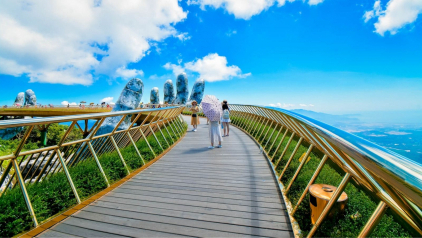Central Vietnam Itinerary: How to Plan A Perfect Route
Central Vietnam is famous for its many scenic spots. Therefore, it might be confusing if you want to spend a specific time discovering all the highlights of the region. If you intend to go to Central Vietnam but don't have a travel plan, this article will help you a lot. So what are you waiting for without scrolling down to see a perfect Central Vietnam itinerary?
How many days to spend in Central Vietnam
Every region in Vietnam has beautiful scenes that captivate people, each has its own characteristics and colors. The central region full of sun and wind is the convergence of many unique cultures and creativity of people that will give visitors a very different and extraordinary feeling. If you have come to Vietnam, don't miss the opportunity to discover the beauty of the sights in Central and understand the culture here.
Compared to the North and the South, the Central offers fewer crowds but tons of fun things to do around. From Quang Binh, Hue, Da Nang, to Hoi An, it is essential to spend at least 5 - 9 days in Central Vietnam exploring the must-visits as well as the must-dos. With the suggested plan below, you will have enough time to visit Hue - Da Nang - Hoi An and other hidden gems in the area.
Best time to visit Central Vietnam
Featuring the distinctive tropical climate in Vietnam, the Central weather is divided into 2 seasons: wet and dry. In the dry season, it is hot and humid with the average temperatures of the mid-30°C. This time between January and August is the perfect time to visit Central Vietnam. For the rest of the year, it is still pleasant to travel around but the rainy season from September to November can cause heavy storms and floods over the region.
To make sure you have a well-arranged plan, please check the Central Vietnam Weather: Definite Guide to see more.
5 Days Central Vietnam Itinerary
Day 1: Da Nang - Hue
The first place for you to depart should be Hue ancient capital. After taking a flight to Da Nang International Airport, you will move to Hue and find a hotel room to rest. A little note for you is that the hotel room may not be available until 2.00 pm. However, early check-in will be guaranteed with extra fees.
After a long and tiring flight and hours from Danang to Hue, you may be tired. So, for the rest of the first day of the Vietnam itinerary in Central, you should relax to recover and prepare for a journey in the following days.
- Soak up the poetic city at night
If you have already boosted your energy after dinner, you can go out and start discovering the Hue nightlife instead of resting at the hotel. Unlike other bustling cities, Hue features its uniqueness and charm at the slow pace of life. Take a cyclo ride to go on a sightseeing tour around the Hue streets. Feel the breezes and admire the scenic beauty of Truong Tien Bridge and Perfume River at night.
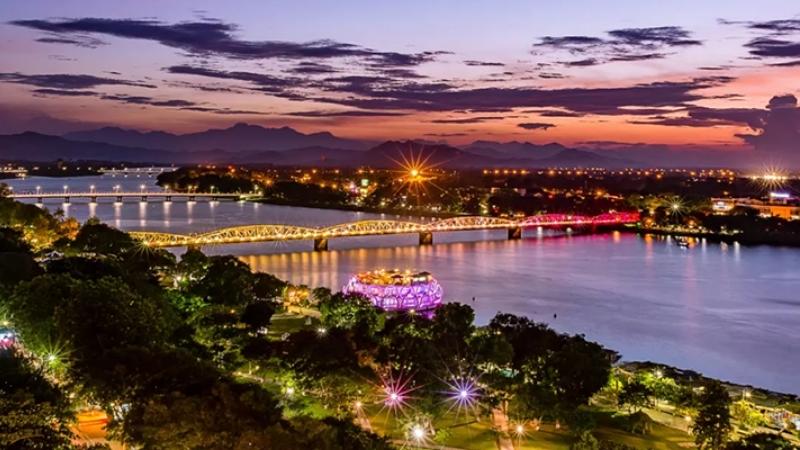
Hue city at night
Day 2: Hue Half-day City Tour
Through the fluctuations of history, Hue is still a beautiful land with peaceful and romantic beauty. It is the land of convergence of cultural quintessence, making a very own nuance of Hue. The values of Hue have been accepted as worthy of the recognition of UNESCO as Vietnam's first World Cultural Heritage in 1993. And now, Hue is one of the most attractive stops for Tourists on the Vietnam tourist map along with a new title: Hue Festival.
- Visit the sacred Thien Mu Pagoda
Okay, so you should start Day 2 of the Central Vietnam Itinerary at 8.00 am and take a boat to visit Thien Mu Pagoda. The pagoda is also known as Linh Mu located on Ha Khe Hill, beside the romantic Huong River, and in the territory of Kim Long Ward, Hue city. Thien Mu Pagoda is a 21-meter high tower consisting of seven floors. Each tower floor has the worship Buddha statues. Inside there is a spiral staircase leading up to the top floor, where it used to worship a golden Buddha image.
Thien Mu Pagoda has the unique architecture of Hue ancient capital. From above, looking down on the overall Thien Mu pagoda, the pagoda is like a giant turtle tortured into the Perfume River. Stone walls were built into two rings surrounding the pagoda.
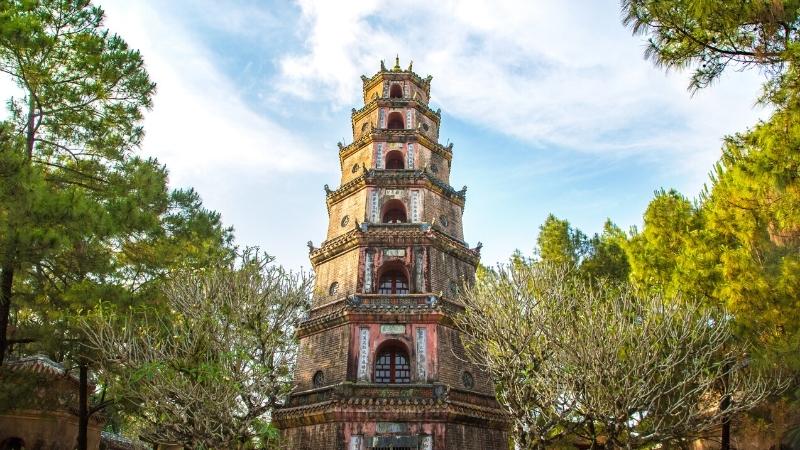
Thien Mu Pagoda
- Observe the daily life at Dong Ba Market
After joining the ancient temple, visit the Dong Ba Market - the largest and most significant market of Hue in particular and Central Vietnam in general. Dong Ba Market is located on a vital route to Hue City, where the beauty of this place is mixed. Having existed since 1899 under King Thanh Thai, Dong Ba market has long been a cultural tourist destination of Hue's ancient capital.
Dong Ba Market consists of a 3-story building in the center, called "cleaning" and is surrounded by rows of houses forming several U-shaped belts. It’s highly recommended to visit the market from the 3rd floor down to be able to admire the whole market. The 3rd floor is the place to sell cloth and clothing items where visitors can choose for themselves or their relatives a lovely Ao Dai with Hue style. The second and part floor of the first floor of the Dong Ba Market makes many tourists not dizzy with sophisticated handicrafts as souvenirs. They are palm-leaf conical hats with prints of a poem, pottery and bamboo products, and so on. Besides, there is a unique gift that represents the oriental culture bronze bells.
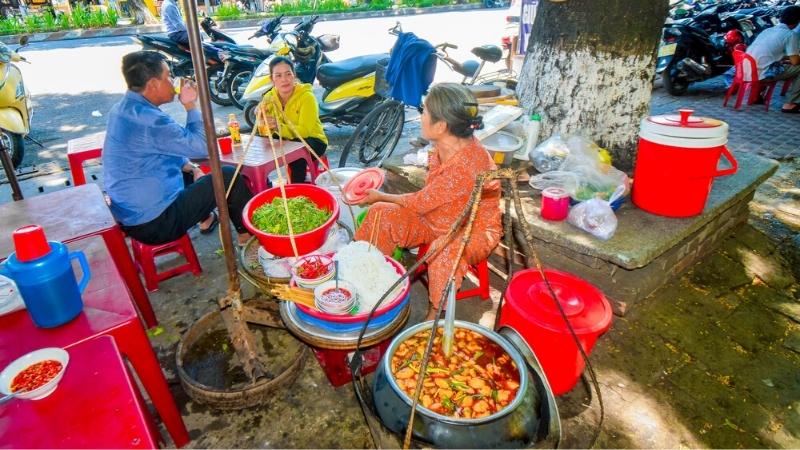
Dong Ba Market
- Explore Hue Imperial Citadel
Having a visit to Hue without exploring the Imperial Citadel is a huge omission. Hue Imperial Citadel was built on a surface of more than 500 ha and limited by three rings of walls. The overall architecture is harmonized with Ngu Binh Mountain and two small islands on the Huong River: Con Hen and Da Vien. That exquisite combination brings feng shui elements related to dragons and tigers (two sacred symbols worshiped in Southeast Asian countries) to protect the Ancient Capital.
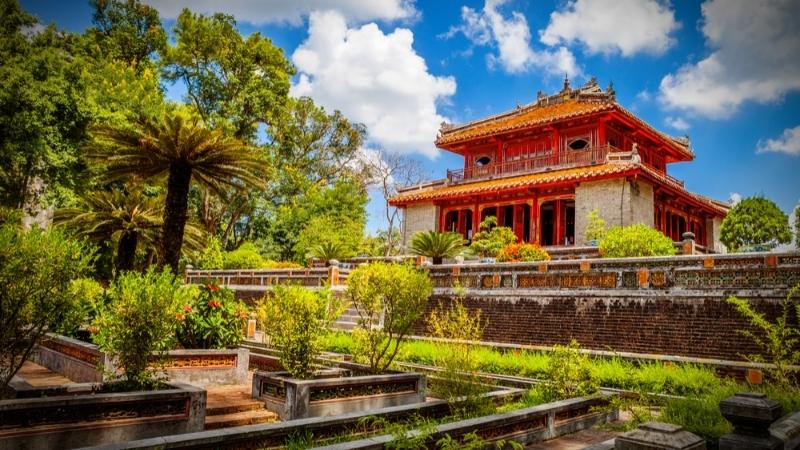
Hue Imperial Citadel
After visiting the Citadel, don’t forget to visit the Hue Royal Antiques Museum to see a collection of decorations. Located in Thanh Noi, this is the earliest established Museum in Hue (192) with the first name is Musee' Khai Dinh. After that, it was changed the name five times. Here exhibits the historical relics of previous dynasties, especially the Nguyen dynasty. If you have a passion for learning history, come here and enjoy this Central Vietnam itinerary.
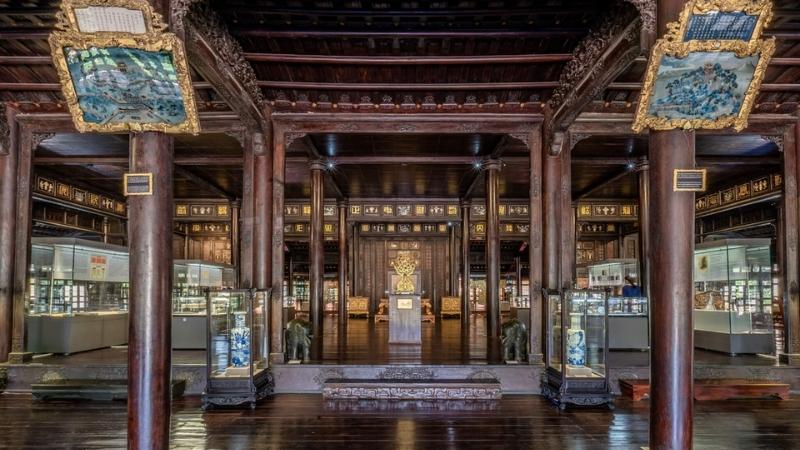
Hue Royal Antiques Museum
- Try the local taste of Hue cuisine
Hue is also a land of cuisine, and you can discover the food here with prices from budget to luxury. The eateries range from the Inner City to the north to the Western Quarter south of the Huong River. The popular dishes that can be mentioned are beef rice noodles and steamed rice cake. Besides, king rice and royal dishes are served in luxury hotels. Hue sweet soup is also delicious cuisine.
After finishing the journey, return to your accommodation to rest after the 2nd day in Central Vietnam.
Day 3: Hue Road Transfer to Hoi An
- Transfer from Hue to Hoi An
After breakfast, you will move to Hoi An ancient town for the 3rd day of the itinerary in Central Vietnam. You should rent a motorbike to move because only using this means will you have the opportunity to stop on the most beautiful coastline, Hai Van Pass. Hai Van Pass is considered the most appealing landscape, located on the Bach Ma mountain range and the natural boundary between Thua Thien - Hue province and Da Nang city. It is 21 km long, the highest peak of the road up to nearly 500m. However, you need to pay close attention because this is one of the most dangerous passes worldwide.
In the past, when there was no tunnel, Hai Van Pass was always crowded with traffic. Today, fewer people move here, then Hai Van Pass keeps its poetic beauty and tranquility. It always welcomes the discoveries of many travelers who love new experiences.
- Feast your eye on spectacular views from Hai Van Pass
Although there is rugged terrain and bends on the side of the abyss, any visitor who has the opportunity to set foot here is attracted by the beauty of one of the most magnificent pass roads in the world. From the top of the pass, when you look south, you will see Da Nang city shrinking and the picturesque sea landscape of Cu Lao Cham, Son Tra Peninsula. Meanwhile, when looking to the north, you will admire both Lang Co Bay and the peaceful green Lap An lagoon. All these beauties have created a picture of captivating people's hearts.
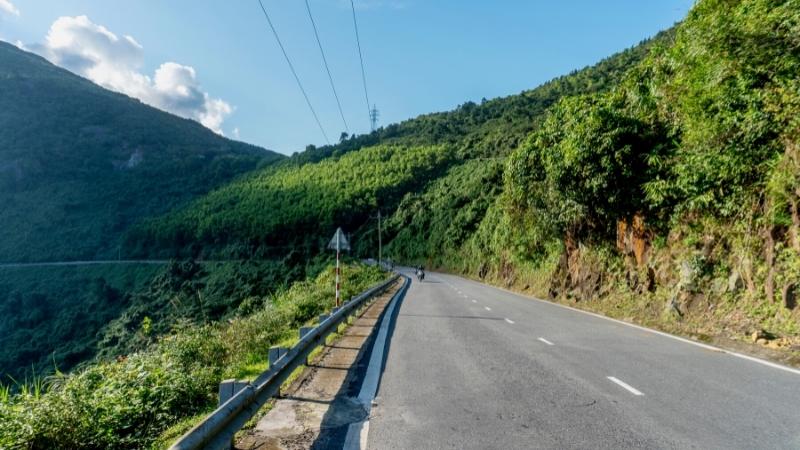
Hai Van pass
- Stop by Marble Mountain
To continue the 5-day Central Vietnam itinerary, don’t forget to stop by Marble Mountain (Ngu Hanh Son). Ngu Hanh Son is the common name for five limestone mountains that rise behind a coastal sandy beach, covering an area of about 2,000 square kilometers. It converges the beauty of natural and heavenly land with historical, cultural, and spiritual values. Therefore, Ngu Hanh Son is a destination to attract tourists, both domestic and foreign.
Ngu Hanh Son has beautiful scenery in all seasons of the year, so you can come here in any season and still admire the same beauty. If you travel in the summer, it will be more appropriate because you can go to the beautiful beaches nearby to swim. The summer is also the high season for many tourists to the Marble Mountains most of the year.
Start the journey to Ngu Hanh Son, you can go to see stone shops at the foot of Ngu Hanh Mountain, where you can find many exquisite stone sculptures here. But you should only look at it and not buy it because you have a long journey to go. If you bring these items, they will be quite heavy. Hence, you just choose for yourself something you like first and then finish the tour of Ngu Hanh Son and come back to buy later.
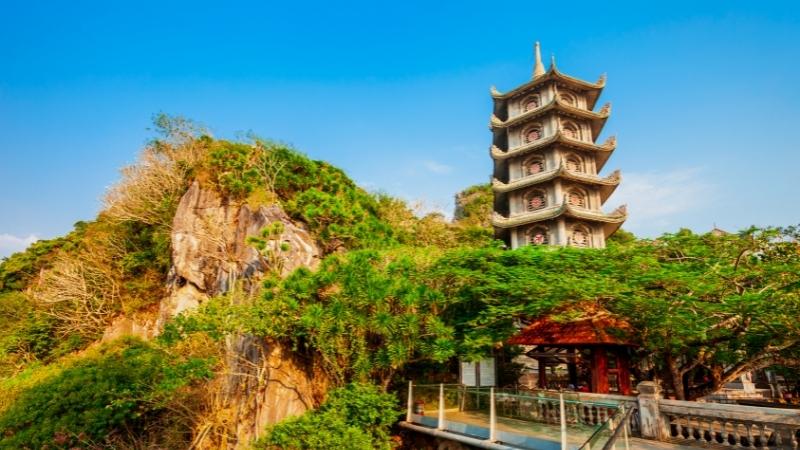
Marble Mountain
- Wander around Hoi An Ancient Town
After visiting Marble Mountain, you will continue your journey to Hoi An and find accommodation. After a little rest, you should go out and take a stroll around Hoi An's ancient town. Hoi An is a city in Quang Nam province with many old towns built in the 16th century and still exists almost intact so far. In the ancient documents of the West region, Hoi An is called Faifo. Hoi An Ancient Town has been recognized as a UNESCO World Heritage Site since 1999. It is the place attracting many tourists from Da Nang - Hoi An. The night is the busiest time here.

Hoi An Ancient Town
According to the statistics of Hoi An, there are 1,360 monuments including 1,068 old houses, 11 ancient wells, 38 ethnic churches, 19 pagodas, 43 shrines, 23 village communal houses, and 44 unique ancient tombs, and a bridge. Despite the moving time, Hoi An ancient town still retains the oldest beauty. It was like a place where one could find a virtually intact ensemble of relics that made Hoi An a unique place in modern chronology. Coming to Hoi An, you will think that you are turning back the time, straying into the traditional atmosphere of a busy commercial port in the Nguyen Dynasty. Hoi An is a place where you can leave all the temptations of everyday life to live fully in every moment.
However, take a gentle walk and get back to your accommodation to rest. You will continue to plan for the next day.
Day 4: My Son Holy Land
- Explore the cultural site of My Son Sanctuary
The next morning, get up early and eat a full breakfast, prepare yourself for a new itinerary. On the 4th day in Central Vietnam, the place you should go to is the My Son temples, one of the World UNESCO Heritage Sites. My Son Holy Land is located in Quang Nam Province, the distance you travel from Danang City to this ancient relic area is 70 km. It is a complex consisting of many clusters of Cham Pa Temples, surrounded by a backdrop of hills and mountains. According to historical records, this is the place where the Champa dynasty organized sacrifices and was the tomb of the ancient Cham Pa royal family. It is probably the center of the main temple of Hinduism in Southeast Asia before.
The Indian temple style influences art and architecture through the temple layout here. The Sanctuary includes many different towers, each of which has a central tower (called "Kalan") and many smaller sub-towers surrounding it. Kalan is the place to worship Linga or worship Shiva (supreme deity in Hindu beliefs). The towers all have pyramids from low to high, symbolizing Mount Meru - the residence of the gods. Currently, the main temples in My Son worship a linga or Shiva god.
- Learn about Vietnamese history and war
Through the cruelty of war and time, the once-magnificent pagoda is now only a ruin. Many archaeologists had previously tried to protect this area. For example, in 1937, French scientists restored almost all the temples here. But after the bombing in 1969, the Tower A area was virtually destroyed - this is the central tower of this monument, the highest temple is 24m high and has six surrounding towers.
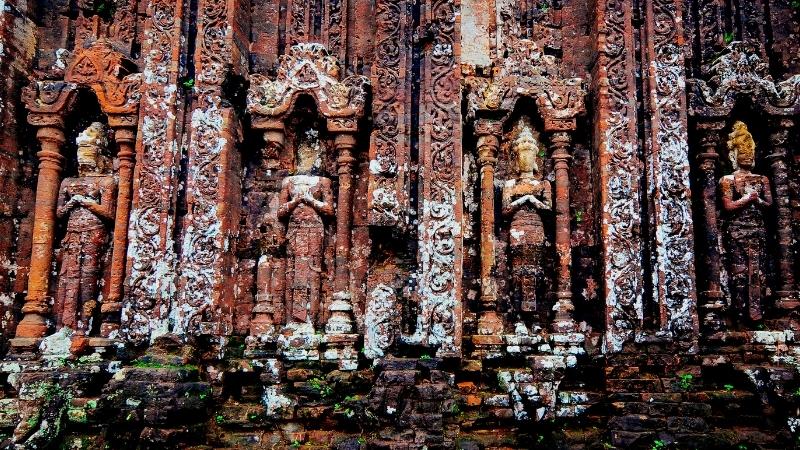
My Son Holy Land
However, the majority of small monuments in areas B, C, and D still exist although many artifacts, colossal statues, and altars are taken away by the French during the war. They have now donated a large number of antiques to the Vietnam Museum of History and the Museum of Cham Sculpture. Don't be surprised when you see Cham Pa artifacts at the famous Louvre museum.
Due to the influence of the Indian philosophical thought and the cult of indigenous faith, right from the beginning of the nation, to pray for the prosperity of the kingdom and strengthen the kingship, the Champa dynasty built the cathedral to worship the gods. That is the fundamental cause when introduced into Champa, the influence of Indian culture is an essential basis for the birth of the religious mecca in My Son, including the architectural complex of temples where Siva is the revered god.
- Uncover the amazing hidden parts
In addition, when visiting here, you will see an ancient road. An Indian expert discovered the road during the excavation and mediation of K Tower in the core zone of My Son World Cultural Heritage. Up to 8 meters wide, the road is led by two parallel walls, the depth of which the buried way is nearly 1 meter in the ground. And according to the documents recorded, this is the first gate that only kings, members of the royal family, and the noblest dignitaries of Champa can go to the central temple to worship the gods.
After unearthing this road, the experts were amazed at the grandiose of this road with the extremely skillful guide system. Very typical construction materials such as earthenware and special adhesive additives for construction are also discovered. This exciting discovery has helped enrich the long-standing historical values, architecture, culture, and art that the ancients have created in both the great community.
Day 5: Hoi An - Da Nang Departure
- Enjoy the laidback town of Hoi An
Save Hoi An for the last day of your journey itinerary in Central Vietnam. Surely this will be an appropriate time for you to discover the beauty and cuisine of Hoi An during the day. Hoi An used to be a busy international port, a meeting place for Japanese, Chinese, and Western merchants. Therefore, Hoi An is heavily influenced by these countries, especially for food. Hoi An cuisine is extremely rich and diverse, with many delicious and unique dishes. Besides the traditional dishes of this city, Hoi An also has many famous dishes from China that attract tourists.
- Try a local taste of street food
For example, chicken rice is a delicious dish on top of the list of individual delicious meals to try when coming to Hoi An. Chicken rice seems nothing special, but in Hoi An, it's terrific. Chicken rice is usually made delicately from the stage of selecting ingredients and processing to enjoy. A plate of chicken rice is presented with a sufficient amount of rice. The chicken is torn out and mixed on top, decorated with some thin laksa leaves, onions, a bit salty, and pepper.
Perhaps you also know that bread is famous street food in Vietnam. When it comes to Hoi An cuisine, visitors are known for famous bread stores like Phuong Bread and Madame Khanh Bread. With the familiar materials but particular recipe, the bread here is described by Anthony Bourdain as "a symphony in a sandwich."
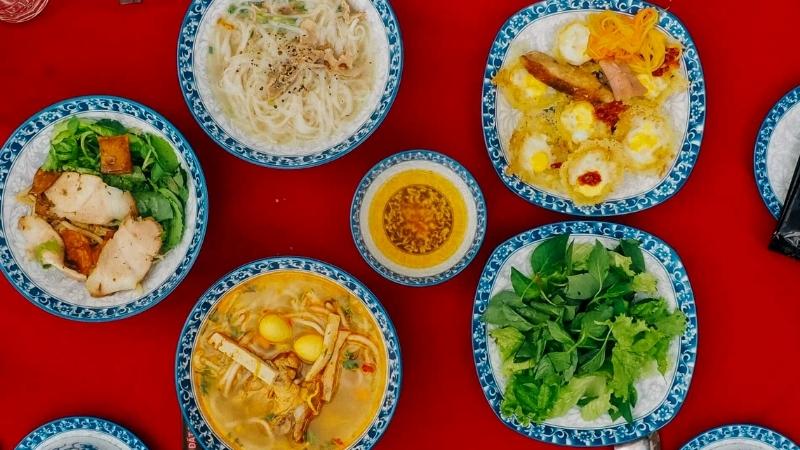
Hoi An local street food
- Visit the vibrant local market
In addition, you can also go to the nearby Hoi An market. It was born in association with the demand for goods exchange of domestic and foreign merchant ships; affirmed its position as a famous trading port of Vietnam for a while. Hoi An market now has many developments, and various kinds of goods are increasingly diverse to serve the shopping and consumption needs of people and visitors.
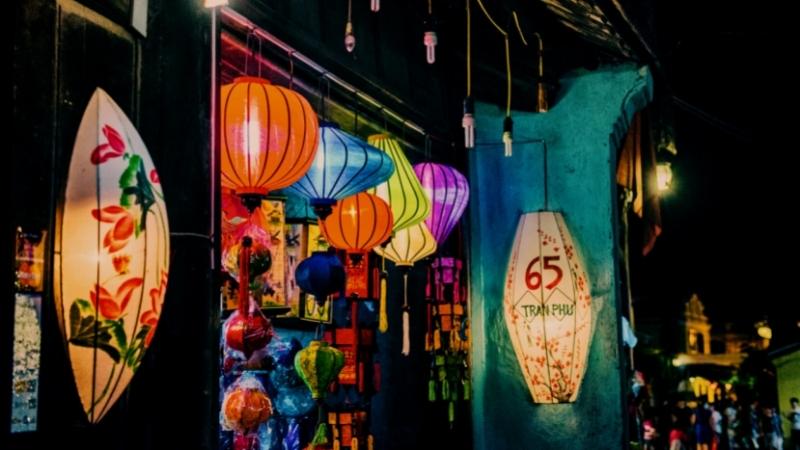
Hoi An lantern street
After exploring Hoi An, spend the remaining half a day going back to Da Nang and exploring this livable city. Da Nang owns many beautiful beaches and impressive bridges across the Han River. Coming to the coastal city, you can immerse yourself in the fresh sea, watch the waves crash, roam the fine sand, and enjoy the beauty of the vast sea. It will also allow you to admire the mysterious, magical beauty of the sea both at dawn and sunset.
It's time to take a trip!
Well, so the five-day journey in Central Vietnam has been completed in detail for you. If you have loved the S-shaped country and have a plan to come here, explore the Central Region once - the land of world natural heritage.
If you find this article useful, don't hesitate to share it with everyone and plan a Central Vietnam itinerary to the charming land.
BestPrice Travel
(Image sources: Internet)
Questions & Answers (6)
How is the weather to Travel to central Vietnam on 9-18 Dec 23, is this a good time for travelling. Thanks
Hi! December is the final month of the rainy season in Central Vietnam, it has less rain than other months of this season. However, if your plan can be changed, we recommend you should visit this area in the period from January to April when it is the dry season here.
Can I ask the driver to stop by Marble Mountain on the way from Hoi An to Hue?
Hi! BestPrice team provides customised tours also, if you have any request for changing the itinerary, please send it to our travel consultant so we can help you to arrange it before your trip to avoid high surcharge.
I'm planning to have a tour in central, after the tour in Hoi An we will continue our journey to Nha Trang. I want to add one day trip to Dalat on my itinerary. it seems that it's not too far from Nha Trang - about 133.5 km via QL27C, as I see on Google Map. Do you have any day tour to Dalat, if not, is it easy to book a transfer? or a day trip in Dalat is too rushed and I have to spend more than one day?
Hi! It's too rush if you want to get from Nha Trang to Dalat and also go sightseeing in Dalat all in a one day tour. It takes at least 3-4 hours for transfering from Nha Trang to Dalat (a returned trip cost 6-8 hours for transfer only). Therefore, we suggest you should spend at least 2 days for a short trip to Dalat.
i will come to Vietnam on 19 Feb 2024, which coincides with Tet holiday in Vietnam. do u know if My Son opens on Tet? if so, would it become less crowded
Hi! Usually, My Son Sanctuary opens all year round including Tet Holiday. Of course, it will be less crowded during this time.
hi there, i wanna add beach relaxation to my upcoming trip to central Vietnam, can u recommend some beaches in Da Nang that offers thrilling water activities? thanks in advance
Son Tra Beach and Cham Island with diving, snorkelling, and parasailing are the right choice for you.







